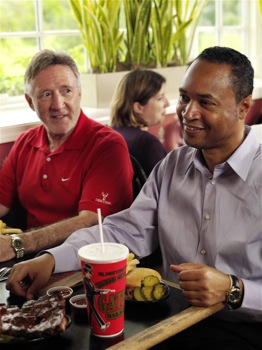
They say that an army marches on its stomach. In my experience, a tour group does as well.
Food is an important part of any trip, and great local flavors can elevate meals from a necessity to a highlight of the travel experience. Throughout America’s heartland, numerous special local and regional dishes offer groups an exciting taste that is distinctive to the areas that they’re visiting.
Some of these dishes, such as Kansas City barbecue or Cincinnati chili, are now-famous variations on some of America’s favorite foods. Others are completely unique to their local areas, like the Dutch letters of Pella, Iowa, and the Limburger cheese made in Green County, Wis.
Whether you’re eating fresh-picked cherries in Traverse City, Mich., or enjoying an Amish haystack dinner in northern Indiana, these fun food experiences will add a dash of flavor to your next group tour in the Midwest.
Kansas City barbecue
There are as many recipes, rubs and secret techniques for cooking barbecue as there are pit masters in the world. Although people eat barbecue in cities and towns from coast to coast, few destinations are as known for their breed of barbecue as Kansas City, Mo.
“When most people think of Kansas City, barbecue comes to mind,” said Derek Klaus, communications manager at the Kansas City Convention and Visitors Association. “Today there are over 100 Kansas City barbecue establishments. Each has its own specialties, such as ribs, pork, chicken, mutton and fish.”
The Kansas City approach to barbecue is defined by slowly smoking meat over wood, usually hickory, for up to 18 hours. Local cook Henry Perry perfected the technique in the 1920s and is now known as the father of Kansas City barbecue.
Today, several of the city’s most popular barbecue establishments are run by those who worked for Perry and learned his technique, then added their own little twists.
Arthur Bryant’s is one of the best known, sitting in its original building downtown. Gates Barbecue is another popular family-run establishment, and Oklahoma Joe’s attracts visitors with its converted gas station and eclectic atmosphere.
“The biggest difference you’ll notice in the different restaurants is the sauce,” Klaus said. “Oklahoma Joe’s has a vinegar taste to it, while some of the sauces at Gates are smoother, with richer flavors.”
Groups that really love their ‘cue should plan to visit during the first weekend of October, when the city hosts American Royal Barbecue, one of the world’s largest barbecue competitions.
www.visitkc.com
Specialty cheese capital
Green County, Wis.
In the 1800s, Swiss immigrants in Wisconsin began making some of their favorite cheeses from home. In the town of Monroe and surrounding Green County, cheesemaking soon became a cottage industry, with more than 200 cheese factories. That tradition still continues.
“Today, there are 13 factories, and they’re making a lot more cheese,” said Noreen Rueckert, Green County tourism director. “Most of those early factories were making Limburger, brick and Swiss cheese. At one time, we were known as the Swiss cheese capital of the country, and now we’re the specialty cheese capital. We have more Wisconsin master cheesemakers than any other county in the state.”
The county’s cheese factories turn out dozens of varieties, including popular Monterey Jack, Swiss and cheddar cheeses, along with gourmet specialties such as Gruyere, Edam and Havarti.
Green County is the only place the country that produces two very special varieties: Limburger, the famously pungent cheese, has been produced by the same cooperative for more than 100 years, and Emmenthaler, a variety of Swiss cheese, comes in large 200-pound wheels.
Groups can visit several of the cheese factories, including the Decatur Dairy, where they can put on hairnets and walk out onto the factory floor. A tour at the National Cheesemaking Center offers a look at how cheeses were made 100 years ago, and the biannual Cheese Days festival in September features freshly made cheese, local beers and Swiss entertainment.
Dutch letters
Pella, Iowa
In central Iowa, not far from Des Moines, the town of Pella markets itself as a tourist destination on the strength of its Dutch heritage. Amidst windmills, artwork and other Old World touches, the Dutch letters are a culinary touch of the Netherlands in the American Midwest.
“The Pella Dutch letters are an almond paste pastry in the shape of the letter ‘S,'” said Jill Vandevoort, director of the Pella Convention and Visitors Bureau. “The letter is significant, because the pastry was created for the Dutch ‘Sinterklauss,’ or St. Nicholas. It was a treat when it was time for Santa Claus to arrive.”
The letters are about 5 or 6 inches long and have become a trademark of the small community, where visitors often purchase some to bring back to friends and family in other parts of the country. Another version of the treat, the almond log, consists of the same pastry baked in a long, straight form.
Groups can sample the almond letters and other Dutch treats at two bakeries in town, Jaarsma and VanderPloeg, which both feature fresh pastries and candies imported from the Netherlands.
“The bakeries are the stores that open the earliest and stay open the latest,” Vandevoort said. “You can get many of the specialty items, like homemade apple crisp pastries, pigs in a blanket and the fluffed pillow, a very flaky pastry with a sweet pudding filling.”
www.pella.org
Cincinnati chili
If you’re a Cincinnati native, you probably describe your favorite chili as simply “three-way,” “four-way” or “five-way.”
“The background is Greek heritage and lineage,” said Ed McMasters, marketing manager for the Cincinnati USA Regional Tourism Network. “The goal was to make a filling meal, so they added pasta and cheese to the chili. That’s called a three-way; a four-way has beans, and a five-way has beans and onions.”
The idea of chili with spaghetti noodles and cheese may sound strange to folks from other parts of the country, but in Cincinnati, most restaurants serve some version of this special blend, each with their own touches. Area cooks are rumored to use chocolate, cinnamon and other unusual ingredients in their recipes.
Two large chili makers, Gold Star Chili and Skyline Chili, have split the population into two loyalties, and both have opened limited numbers of stores in other parts of Ohio and Kentucky.
“If you’re a Gold Star person, that’s where you go,” McMasters said. “If you’re a Skyline person, that’s where you go, and you rarely mix. It’s very much in pockets, and it’s about where you grew up.”
In addition to the chains, groups can find great chili at favorite local spots such as Price Hill Chili on the west side of town, where the staff sells buckets of the stuff to go on Friday nights during high school football season.
www.cincinnatiusa.com
Tart cherries
Traverse City, Mich.
You don’t have to spend much time in Traverse City, Mich., to realize that this city loves its cherries.
“Everything in Traverse City seems to have a cherry theme attached to it, from Cherry Capital Airport to Cherryland Electric Cooperative,” said Mike Norton, media relations representative of the Traverse City Convention and Visitors Bureau. “It’s a rare restaurant that doesn’t have at least one cherry-laced sauce, dessert or entree and a rare gathering where bowls of dried cherries aren’t on hand for snacking.
A Presbyterian missionary to the local Indians planted the first cherry tree in the area in 1852. The tree flourished thanks to the area’s moderate temperatures, and more settlers began to plant cherry trees. Today, the Traverse City area produces more than 75 percent of the world’s tart cherries.
Groups can get a taste for the breadth of cherry products from the area during the annual National Cherry Festival, a weeklong event that takes place during July. At other times of year, tourists can visit numerous you-pick cherry orchards or stores such as Cherry Republic, which sells more than 150 cherry products.
“In Traverse City, you’ll find cherries in everything from beer and wine to cherry vinaigrette salad dressing, bratwurst and beef patties,” Norton said. “We use them in trail mix, snack foods, cookies, on top of salads and in sauces.”
For more America’s heartland:
History thrives
Agritourism’s harvest
Get hip to the urban heartland
Conner Prairie
Elkhart County’s Amish haystack
Agritourism on the cusp of suburbia
Tasting the Old World










